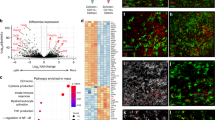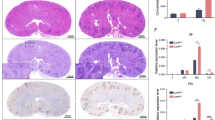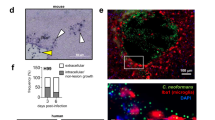Abstract
The C-type lectin receptor–Syk (spleen tyrosine kinase) adaptor CARD9 facilitates protective antifungal immunity within the central nervous system (CNS), as human deficiency in CARD9 causes susceptibility to fungus-specific, CNS-targeted infection. CARD9 promotes the recruitment of neutrophils to the fungus-infected CNS, which mediates fungal clearance. In the present study we investigated host and pathogen factors that promote protective neutrophil recruitment during invasion of the CNS by Candida albicans. The cytokine IL-1β served an essential function in CNS antifungal immunity by driving production of the chemokine CXCL1, which recruited neutrophils expressing the chemokine receptor CXCR2. Neutrophil-recruiting production of IL-1β and CXCL1 was induced in microglia by the fungus-secreted toxin Candidalysin, in a manner dependent on the kinase p38 and the transcription factor c-Fos. Notably, microglia relied on CARD9 for production of IL-1β, via both transcriptional regulation of Il1b and inflammasome activation, and of CXCL1 in the fungus-infected CNS. Microglia-specific Card9 deletion impaired the production of IL-1β and CXCL1 and neutrophil recruitment, and increased fungal proliferation in the CNS. Thus, an intricate network of host–pathogen interactions promotes antifungal immunity in the CNS; this is impaired in human deficiency in CARD9, which leads to fungal disease of the CNS.
This is a preview of subscription content, access via your institution
Access options
Access Nature and 54 other Nature Portfolio journals
Get Nature+, our best-value online-access subscription
$29.99 / 30 days
cancel any time
Subscribe to this journal
Receive 12 print issues and online access
$209.00 per year
only $17.42 per issue
Buy this article
- Purchase on Springer Link
- Instant access to full article PDF
Prices may be subject to local taxes which are calculated during checkout








Similar content being viewed by others
Data availability
The data that support the findings of this study are available from the corresponding authors upon request.
References
Lionakis, M. S. & Levitz, S. M. Host control of fungal infections: lessons from basic studies and human cohorts. Annu. Rev. Immunol. 36, 157–191 (2018).
Drummond, R. A. & Lionakis, M. S. Mechanistic insights into the role of C-type lectin receptor/CARD9 signaling in human antifungal immunity. Front. Cell Infect. Microbiol. 6, 39 (2016).
Glocker, E. O. et al. A homozygous CARD9 mutation in a family with susceptibility to fungal infections. N. Engl. J. Med. 361, 1727–1735 (2009).
Lanternier, F. et al. Deep dermatophytosis and inherited CARD9 deficiency. N. Engl. J. Med. 369, 1704–1714 (2013).
Drummond, R. A. et al. CARD9-dependent neutrophil recruitment protects against fungal invasion of the central nervous system. PLoS Pathog. 11, e1005293 (2015).
Li, X. et al. The β-glucan receptor Dectin-1 activates the integrin Mac-1 in neutrophils via Vav protein signaling to promote Candida albicans clearance. Cell Host Microbe 10, 603–615 (2011).
Drewniak, A. et al. Invasive fungal infection and impaired neutrophil killing in human CARD9 deficiency. Blood 121, 2385–2392 (2013).
Altmeier, S. et al. IL-1 coordinates the neutrophil response to C. albicans in the oral mucosa. PLOS Pathog. 12, e1005882 (2016).
Karki, R. et al. Concerted activation of the AIM2 and NLRP3 inflammasomes orchestrates host protection against Aspergillus infection. Cell Host Microbe 17, 357–368 (2015).
Biondo, C. et al. The interleukin-1β/CXCL1/2/neutrophil axis mediates host protection against group B streptococcal infection. Infect. Immun. 82, 4508–4517 (2014).
Nemeth, T., Futosi, K., Sitaru, C., Ruland, J. & Mocsai, A. Neutrophil-specific deletion of the CARD9 gene expression regulator suppresses autoantibody-induced inflammation in vivo. Nat. Commun. 7, 11004 (2016).
Wang, X. et al. Impaired specific antifungal immunity in CARD9-deficient patients with phaeohyphomycosis. J. Invest. Dermatol. 138, 607–617 (2018).
Lionakis, M. S. et al. Chemokine receptor Ccr1 drives neutrophil-mediated kidney immunopathology and mortality in invasive candidiasis. PLoS Pathog. 8, e1002865 (2012).
Lee, E. K. S. et al. Leukotriene B4-mediated neutrophil recruitment causes pulmonary capillaritis during lethal fungal sepsis. Cell Host Microbe 23, 121–133.e124 (2018).
Swamydas, M. et al. CXCR1-mediated neutrophil degranulation and fungal killing promote Candida clearance and host survival. Sci. Trans. Med. 8, 322ra310–322ra310 (2016).
Ngo, L. Y. et al. Inflammatory monocytes mediate early and organ-specific innate defense during systemic candidiasis. J. Infect. Dis. 209, 109–119 (2014).
Erwig, L. P. & Gow, N. A. R. Interactions of fungal pathogens with phagocytes. Nat. Rev. Microbiol. 14, 163–176 (2016).
Zheng, X., Wang, Y. & Wang, Y. Hgc1, a novel hypha-specific G1 cyclin-related protein regulates Candida albicans hyphal morphogenesis. EMBO J. 23, 1845–1856 (2004).
Moyes, D. L. et al. Candidalysin is a fungal peptide toxin critical for mucosal infection. Nature 532, 64–68 (2016).
Verma, A. H. et al. Oral epithelial cells orchestrate innate type 17 responses to Candida albicans through the virulence factor candidalysin. Sci. Immunol. 2, eaam8834 (2017).
Richardson, J. P. et al. Candidalysin drives epithelial signaling, neutrophil recruitment, and immunopathology at the vaginal mucosa. Infect. Immun. 86, e00645–17 (2017).
Naglik, J. R., Challacombe, S. J. & Hube, B. Candida albicans secreted aspartyl proteinases in virulence and pathogenesis. Microbiol. Mol. Biol. Rev. 67, 400–428 (2003).
Gabrielli, E. et al. In vivo induction of neutrophil chemotaxis by secretory aspartyl proteinases of Candida albicans. Virulence 7, 819–825 (2016).
Pericolini, E. et al. Secretory aspartyl proteinases cause vaginitis and can mediate vaginitis caused by Candida albicans in mice. mBio 6, e00724–15 (2015).
Henn, A. et al. The suitability of BV2 cells as alternative model system for primary microglia cultures or for animal experiments examining brain inflammation. Altex-Alternativen Zu Tierexperimenten 26, 83–94 (2009).
Hennessy, E., Griffin, É. W. & Cunningham, C. Astrocytes are primed by chronic neurodegeneration to produce exaggerated chemokine and cell infiltration responses to acute stimulation with the cytokines IL-1β and TNF-α. J. Neurosci 35, 8411–8422 (2015).
Pineau, I., Sun, L., Bastien, D. & Lacroix, S. Astrocytes initiate inflammation in the injured mouse spinal cord by promoting the entry of neutrophils and inflammatory monocytes in an IL-1 receptor/MyD88-dependent fashion. Brain Behav. Immun. 24, 540–553 (2010).
Omari, K. M., John, G., Lango, R. & Raine, C. S. Role for CXCR2 and CXCL1 on glia in multiple sclerosis. Glia 53, 24–31 (2005).
Poeck, H. et al. Recognition of RNA virus by RIG-I results in activation of CARD9 and inflammasome signaling for interleukin 1β production. Nat. Immunol. 11, 63–69 (2009).
Pereira, M., Tourlomousis, P., Wright, J., P Monie, T. & Bryant, C. E. CARD9 negatively regulates NLRP3-induced IL-1β production on Salmonella infection of macrophages. Nat. Commun. 7, 12874–12874 (2016).
Kasper, L. et al. The fungal peptide toxin Candidalysin activates the NLRP3 inflammasome and causes cytolysis in mononuclear phagocytes. Nat. Commun. 9, 4260 (2018).
Parkhurst, C. N. et al. Microglia promote learning-dependent synapse formation through BDNF. Cell 155, 1596–1609 (2013).
Pappas, P. G., Lionakis, M. S., Arendrup, M. C., Ostrosky-Zeichner, L. & Kullberg, B. J. Invasive candidiasis. Nat. Rev. Dis. Primers 4, 18026 (2018).
Lionakis, M. S., Netea, M. G. & Holland, S. M. Mendelian genetics of human susceptibility to fungal infection. Cold Spring Harbor Perspect. Med. 4, a019638 (2014).
McCarthy, M. W., Kalasauskas, D., Petraitis, V., Petraitiene, R. & Walsh, T. J. Fungal infections of the central nervous system in children. J. Pediatr. Infect. Dis. Soc. 6, e123–e133 (2017).
Drummond, R. A. & Lionakis, M. S. Candidiasis of the central nervous system in neonates and children with primary immunodeficiencies. Curr. Fungal Infect. Rep. 12, 92–97 (2018).
Cetinkaya, P. G. et al. A young girl with severe cerebral fungal infection due to card 9 deficiency. Clin. Immunol. 191, 21–26 (2018).
Lanternier, F. et al. Inherited CARD9 deficiency in otherwise healthy children and adults with Candida species-induced meningoencephalitis, colitis, or both. J. Allergy Clin. Immunol. 135, 1558–1568 (2015).
Del Rio, L., Bennouna, S., Salinas, J. & Denkers, E. Y. CXCR2 deficiency confers impaired neutrophil recruitment and increased susceptibility during Toxoplasma gondii infection. J. Immunol. 167, 6503–6509 (2001).
Bonnett, C. R., Cornish, E. J., Harmsen, A. G. & Burritt, J. B. Early neutrophil recruitment and aggregation in the murine lung inhibit germination of Aspergillus fumigatus conidia. Infect. Immun. 74, 6528–6539 (2006).
Lévesque, S. A. et al. Myeloid cell transmigration across the CNS vasculature triggers IL-1β-driven neuroinflammation during autoimmune encephalomyelitis in mice. J. Exp. Med. 213, 929–949 (2016).
Hanamsagar, R., Aldrich, A. & Kielian, T. Critical role for the AIM2 inflammasome during acute CNS bacterial infection. J. Neurochem. 129, 704–711 (2014).
Prinz, M., Erny, D. & Hagemeyer, N. Ontogeny and homeostasis of CNS myeloid cells. Nat. Immunol. 18, 385–392 (2017).
Shinozaki, Y. et al. Transformation of astrocytes to a neuroprotective phenotype by microglia via P2Y1 receptor downregulation. Cell Rep. 19, 1151–1164 (2017).
Rothhammer, V. et al. Microglial control of astrocytes in response to microbial metabolites. Nature 557, 724–728 (2018).
Mao, L. et al. Pathogenic fungus Microsporum canis activates the NLRP3 inflammasome. Infect. Immun. 82, 882–892 (2014).
Goodridge, H. S. et al. Differential use of CARD9 by Dectin-1 in macrophages and dendritic cells. J. Immunol. 182, 1146–1154 (2009).
Weinblatt, M. E. et al. An oral spleen tyrosine kinase (Syk) inhibitor for rheumatoid arthritis. N. Engl. J. Med. 363, 1303–1312 (2010).
Flynn, R. et al. Targeting Syk-activated B cells in murine and human chronic graft-versus-host disease. Blood 125, 4085–4094 (2015).
Ruland, J., Duncan, G. S., Wakeham, A. & Mak, T. W. Differential requirement for Malt1 in T and B cell antigen receptor signaling. Immunity 19, 749–758 (2003).
Tay, T. L. et al. A new fate mapping system reveals context-dependent random or clonal expansion of microglia. Nat. Neurosci. 20, 793–803 (2017).
Goldmann, T. et al. A new type of microglia gene targeting shows TAK1 to be pivotal in CNS autoimmune inflammation. Nat. Neurosci. 16, 1618–1626 (2013).
Lionakis, M. S., Lim, J. K., Lee, C. C. R. & Murphy, P. M. Organ-specific innate immune responses in a mouse model of invasive candidiasis. J. Innate Immun. 3, 180–199 (2011).
Cougnoux, A. et al. Microglia activation in Niemann–Pick disease, type C1 is amendable to therapeutic intervention. Hum. Mol. Genet. 27, 2076–2089 (2018).
Acknowledgments
This work was supported by the Intramural Research Program of the National Institute of Allergy and Infectious Disease, National Institutes of Health, as well as NIH grants awarded to T.M.H. (no. R01 093808), S.G.F. (no. R01AI124566) and S.A.L. (no. R01CA161373). Additional funding was provided by the Burroughs Wellcome Fund (awarded to T.M.H.), the Wellcome Trust (nos. 102705 and 097377; awarded to G.D.B.), the MRC Centre for Medical Mycology and the University of Aberdeen (no. MR/N006364/1; awarded to G.D.B.). The authors additionally thank C. Huaman for care and screening of the Malt1–/– mice, which were a kind gift to B.C.S. from T. Mak and the University Health Network (Canada), and D. McGavern and F. Crews for providing the murine glial cell lines.
Author information
Authors and Affiliations
Contributions
R.A.D. and M.S.L. designed the study. R.A.D., M.S., V.O., B.Z. and I.M.D. performed the experiments. R.A.D., M.S., V.O., B.Z., I.M.D., T.M.H. and M.S.L. analyzed the data. B.C.S., A.C.B., K.D.M.-B., S.A.L., Y.I., S.G.F., G.D.B., B.H., J.R.N. and T.M.H. provided key reagents/mouse lines and intellectual input into the experimental design regarding their use. R.A.D. and M.S.L. wrote the manuscript.
Corresponding authors
Ethics declarations
Competing interests
The authors declare no competing interests.
Additional information
Publisher’s note: Springer Nature remains neutral with regard to jurisdictional claims in published maps and institutional affiliations.
Integrated supplementary information
Supplementary Figure 1 Microglia express CARD9-coupled C-type lectin receptors.
Microglia were MACS-sorted from uninfected wild-type brains and analyzed for expression of the indicated C-type lectin receptors (and Card9 as control) by qRT-PCR, relative to Gapdh. Each point represents pooled microglia from an individual mouse (n = 4 animals). Data presented as mean +/− SEM.
Supplementary Figure 2 Gating strategy used to define myeloid cells in the C. albicans-infected brain.
Gates and their associated frequency are outlined in blue. Titles in blue above each plot denote the cell population being defined in that plot.
Supplementary Figure 3 Optimal neutrophil phagocytosis of Candida requires Dectin-1 and Dectin-2 in the C. albicans-infected brain.
Dectin-1 (n = 4 animals) and Dectin-2-deficient (n = 5 animals) mice and their wild-type controls (n = 13 animals) were infected with 5 × 106 green fluorescent protein (GFP)-expressing C. albicans and brain leukocytes analyzed 2 h later by flow cytometry, using the gating strategy shown in Supplementary Fig. 2. The percentage of GFP+ neutrophils was used as a measure of in vivo phagocytosis. Each point represents an individual mouse. Data is pooled from 2-3 experiments and shown as mean +/− SEM. Histograms are gated on live CD45+ Ly6G+ CD11b+ neutrophils. *P = 0.0314 (WT vs Clec7a–/–), *P=0.0192 (WT vs Clec4n–/–) by unpaired two-tailed t-test.
Supplementary Figure 4 Chemoattractant receptors LTB4R1 and FPR1 are not required for protective neutrophil recruitment to the fungus-infected brain.
Animals deficient in chemoattractant receptors were infected and analyzed as described for Fig. 1 for (a) neutrophil recruitment to the brain at 24 h (WT n = 9 animals, Ltb4r1–/– n = 9 animals; WT n = 6 animals, Fpr1–/– n = 8 animals), and (b) fungal burdens at 72 h post-infection (24 h: WT n = 9 animals, Ltb4r1–/– n = 6 animals; WT n = 6 animals, Fpr1–/– n = 8 animals; 72 h: WT n = 8 animals, Ltb4r1–/– n = 5 animals; WT n = 6 animals, Fpr1–/– n = 6 animals). ‘Wild type’ refers to appropriate matched control animals for each knock-out line for gender, age and genetic background. Individual points represent different mice. Data is pooled from 2-3 independent experiments and shown as mean +/− SEM, and analyzed by unpaired two-tailed t-test (panel a) or two-tailed Mann Whitney U-test (panel b).
Supplementary Figure 5 Abundance and activation markers of Card9–/– microglia.
The number of microglia from Card9+/+ and Card9–/– mice were determined at the steady-state and during infection at the indicated time points (left; 0 h: WT n = 7 animals, Card9–/– n = 5 animals; 24 h : WT n = 10 animals, Card9–/– n = 11 animals; 72 h: WT n = 13 animals, Card9–/– n = 12 animals). Expression levels of lineage and activation markers were determined in 8-10-week-old uninfected mice by flow cytometry (right; WT n = 7 animals, Card9–/– n = 7 animals). Data shown is pooled from 2-3 independent experiments and presented as mean +/− SEM. Each point represents an individual animal.
Supplementary Figure 6 Microglia-specific deletion of Card9 in Card9fl/flCx3cr1CreER+/– mice.
Microglia and Ly6Chi monocytes were FACS-sorted from 24 h infected brains from Card9fl/flCx3cr1CreER–/– and Card9fl/flCx3cr1CreER+/– littermates that had been tamoxifen-pulsed 4 weeks earlier. Cells were pooled from 4-5 brains per group, and Card9 expression quantified by qRT-PCR relative to Gapdh. Data is pooled from 2 independent sorting experiments. Bar charts show the mean of the data, points represent the result from each independent sorting experiment (n = 2 independent experiments).
Supplementary Figure 7 CARD9-dependent glial antifungal immunity in the CNS.
Schematic depiction of the Candidalysin–IL-1β–CXCL1 protective immune axis acting via CARD9-expressing microglia to mediate protective neutrophil accumulation to the brain following invasive C. albicans infection of the CNS.
Supplementary information
Rights and permissions
About this article
Cite this article
Drummond, R.A., Swamydas, M., Oikonomou, V. et al. CARD9+ microglia promote antifungal immunity via IL-1β- and CXCL1-mediated neutrophil recruitment. Nat Immunol 20, 559–570 (2019). https://doi.org/10.1038/s41590-019-0377-2
Received:
Accepted:
Published:
Issue Date:
DOI: https://doi.org/10.1038/s41590-019-0377-2
This article is cited by
-
Invasive candidiasis
Nature Reviews Disease Primers (2024)
-
Resveratrol ameliorates glioblastoma inflammatory response by reducing NLRP3 inflammasome activation through inhibition of the JAK2/STAT3 pathway
Journal of Cancer Research and Clinical Oncology (2024)
-
Secretion of the fungal toxin candidalysin is dependent on conserved precursor peptide sequences
Nature Microbiology (2024)
-
Global fungal-host interactome mapping identifies host targets of candidalysin
Nature Communications (2024)
-
Noteworthy perspectives on microglia in neuropsychiatric disorders
Journal of Neuroinflammation (2023)



